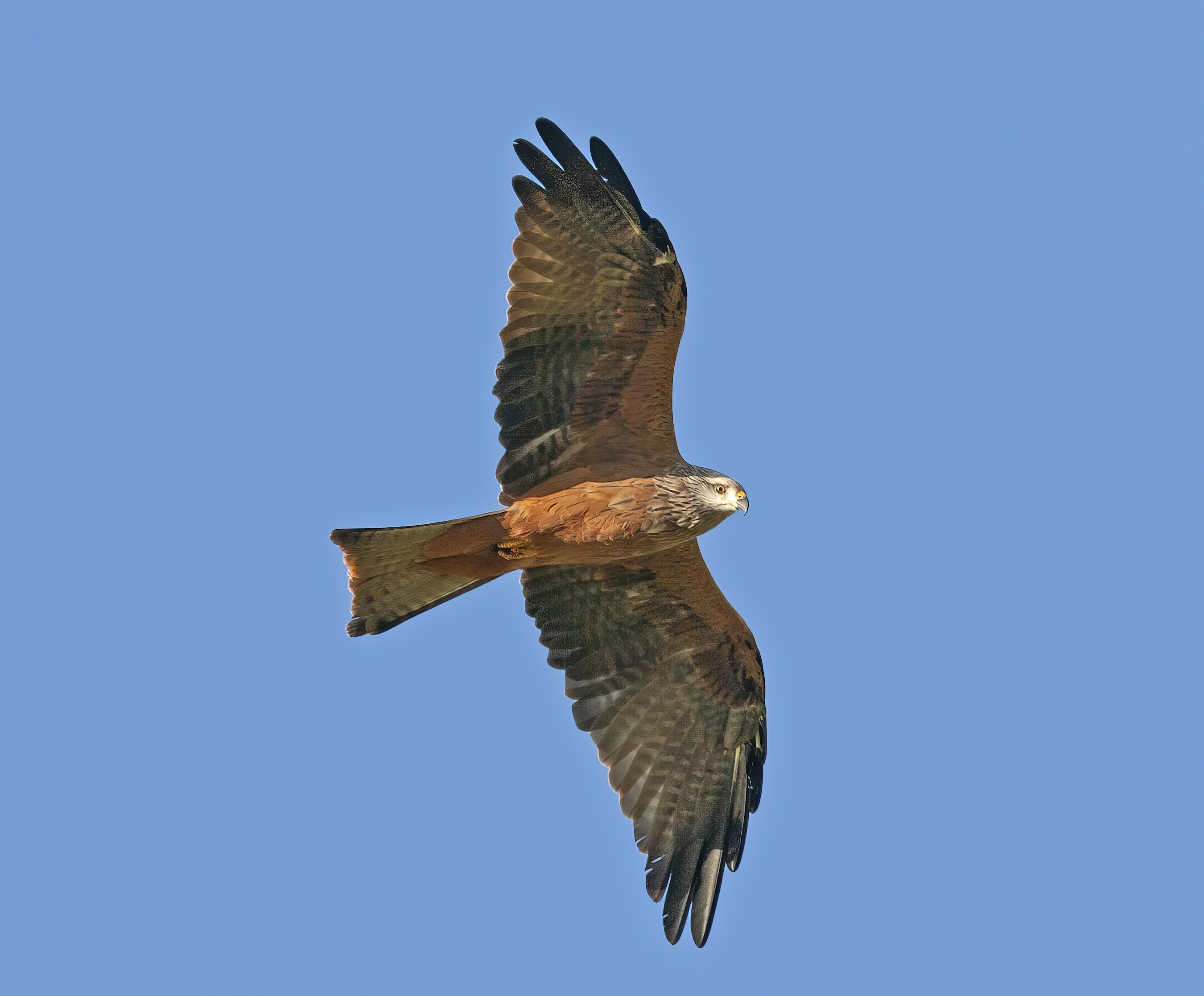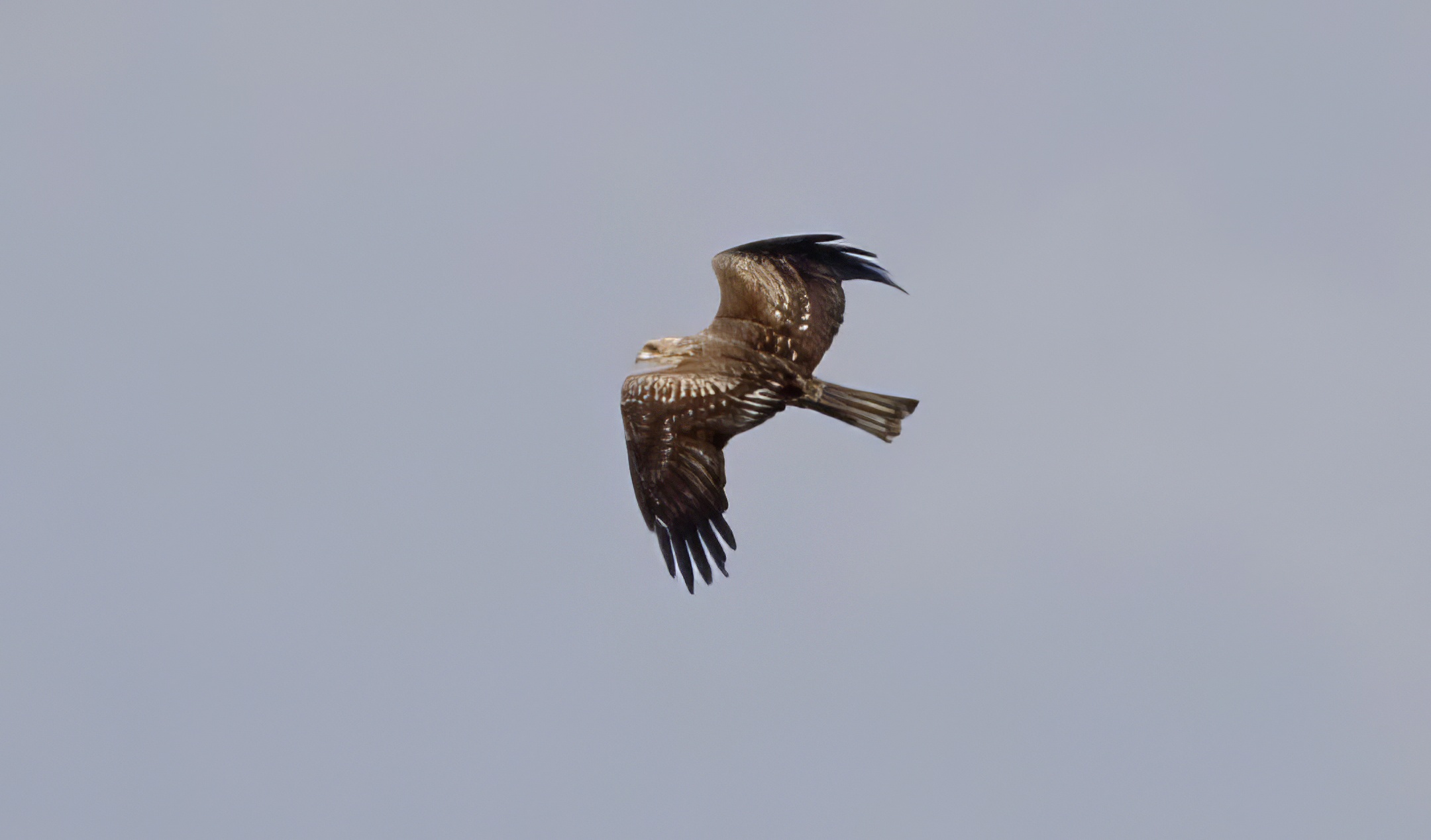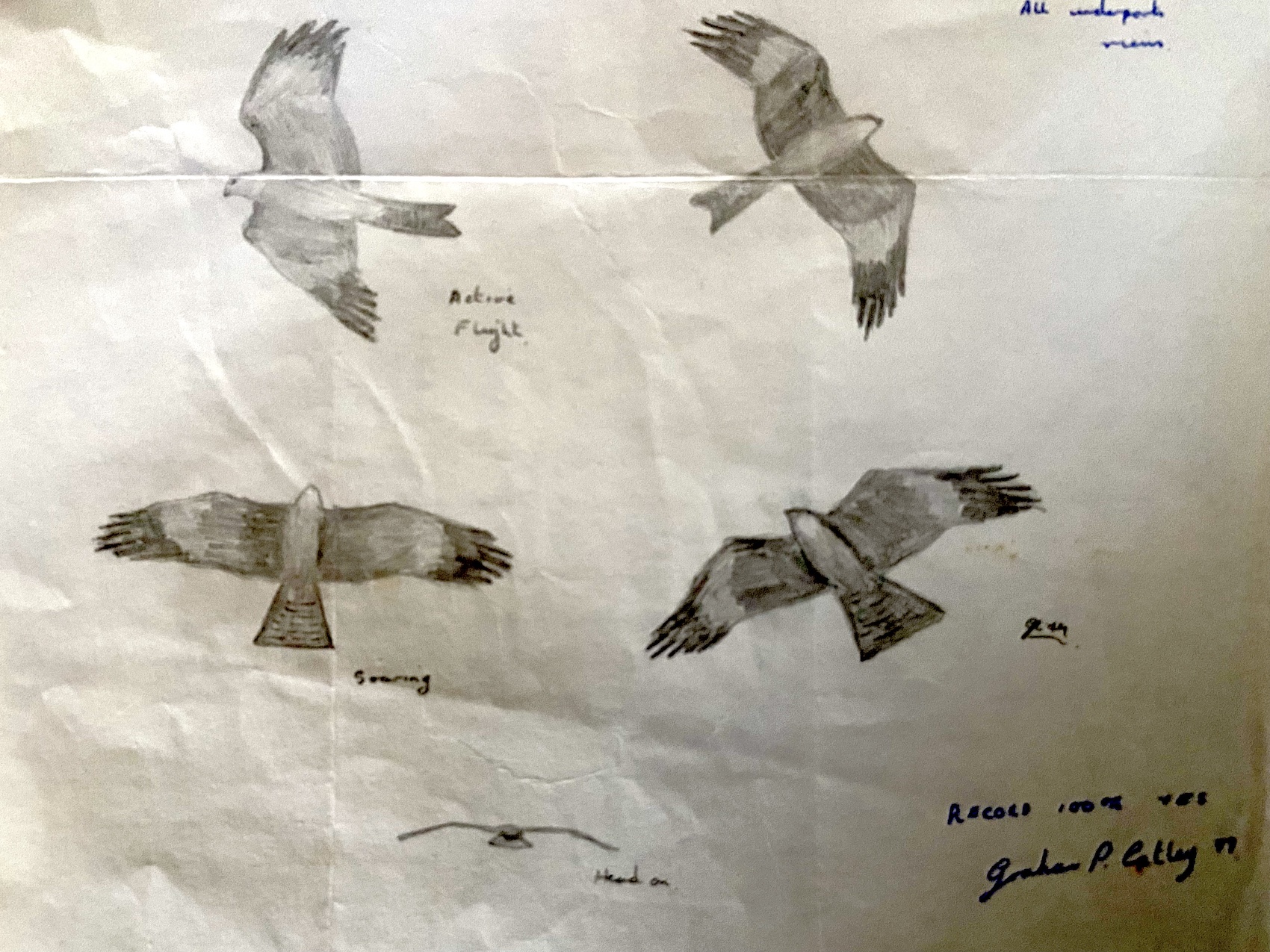Black Kite Milvus migrans


The first record for the county was on May 18th, 1979, since when there have been about 12 further records allowing for duplications in years when the same individual was presumed seen at several sites. It remains a county rarity with records in only six years since 2000, most recently in May 2020. A bird seen on the Humber bank in November 2014 was thought to be an escaped Yellow-billed Kite Milvus aegyptius and is not included in these records.
A juvenile Black Kite of an as yet unassigned sub-species was found at Butterwick Marsh-Freiston Shore in November 2006. It wandered around adjacent areas of The Wash and inland fields and was seen at Benington, Holbeach Marsh, Welland Mouth, and Frampton Marsh. It spent the winter along the north Norfolk coast and was then seen at Gibraltar Point February 2007 before flying back to Norfolk and was last seen mid-April 2007. It was thought to be of the eastern race M.m. lineatus, Black-eared Kite, but the taxonomy of the eastern Black Kites is still in flux and this record awaits further adjudication.
It is noteworthy that most European Black Kites of the nominate race have largely moved out of Europe by early autumn with peak crossing at Gibraltar in August and few in September, so any occurring in late autumn in Britain should prompt close examination. In Britain as a whole Black Kite was formerly a rare vagrant (or an under-recorded one) and the county first in 1979 was one of seven accepted British records that year. During the decade of the 1970s there were just 29 British records, but numbers increased during the 1980s when there were 100 and continued into the 1990s when there were 152. This veritable avalanche of records continued into the 2000s with 75 in the first five years of the new millennium. The upsurge in records started 1979-80 when they began breeding in Belgium. BBRC also reminded us that more than 50% of records, 2000–04, were rejected, female/immature Marsh Harriers being the bogey bird. The species became ex-BBRC from January 1st 2006. Up to the end of 2017, the total number of British records stood at 360. BBRC noted that it had the highest rejection rate of any BBRC rarity.
| Site | First date | Last date | Count | Notes |
| East Halton | 18/05/1979 | 1 | ||
| Burgh le Marsh | 14/04/1988 | 1 | ||
| Gibraltar Point NNR | 17/04/1988 | 1 | ||
| Gibraltar Point NNR | 25/04/1988 | 1 | Same as bird of 17/4 | |
| Gibraltar Point NNR | 12/05/1988 | 13/05/1988 | 1 | Same as bird of 17/4; also seen at Wainfleet 12/5. |
| Frampton and Holbeach Marsh | 09/06/1989 | 1 | ||
| Gibraltar Point NNR | 30/04/1993 | 1 | Flew south | |
| Gibraltar Point NNR | 16/05/1993 | 1 | Flew south, considered a different bird from 30/4; also seen in Norfolk | |
| Boston | 04/06/1994 | 1 | Flew low west over N side of Boston | |
| Freiston Shore | 02/11/2006 | 21/11/2006 | 1 | One of the eastern races (see below) |
| Gibraltar Point NNR | 17/02/2007 | 1 | Same as bird of 2/11; briefly present before heading towards Norfolk | |
| Terrington | 17/04/2007 | 1 | Same as bird of 2/11; last sighting in Lincolnshire | |
| Barton Pits | 21/05/2007 | 1 | ||
| Saltfleetby-Theddlethorpe NNR | 24/05/2007 | 1 | Same as bird of 21/5/2007 | |
| Sandilands, Sutton on Sea | 24/05/2007 | 1 | Same as bird of 21/5/2007 | |
| Nocton Heath* | 16/07/2007 | 07/11/2007 | 1 | Thought to be the same as bird of 21/5/2007 |
| Farforth | 23/04/2011 | 24/04/2011 | 1 | |
| Gibraltar Point NNR | 03/05/2011 | 1 | Also on May 12th-13th and 31st | |
| Donna Nook | 09/04/2015 | 1 | Flew slowly north | |
| Alkborough Flats | 03/05/2019 | 1 | ||
| Gibraltar Point NNR | 07/05/2020 | 1 |
*Although somewhat controversial, thought to be the same as the individual at Barton May 2007. Study of the plumage showed that it had similar wear in the tail and wing feathers and to have similar primary moult characteristics. By the end of its stay, it had completed wing moult.
Note with reference to the Lincolnshire Black Kite, 2006-7 (Subspecies information, Black Kite, BBRC website, December 2017)
Nominate migrans is a scarce migrant to Britain. The subspecies lineatus is not on the British List but might be a potential vagrant. BBRC has received a submission for the bird in Lincolnshire and Norfolk in 2006/07 but not the widely reported bird in Powys in 2010. The subspecies lineatus differs slightly from nominate migrans in size, structure and plumage but firm identification is difficult due to widespread intergradation across Russia, western Siberia and Central Asia (Forsman 2016, Lindholm & Forsten 2011). The former author recommends close scrutiny of the colour of the feet and cere, wing formula and under-primary pattern and, on adults, iris colour and the colour of the head feathering. BBRC welcomes submissions of any individuals showing evidence of an eastern origin but it may only be possible to publish ‘promising’ birds as ‘held’. There will also potentially be issues of captive origin and of Black x Red Kite hybrids in assessing any claim of lineatus (Carter 2007). For further details see https://www.bbrc.org.uk/subspecies-information/birds-of-prey).
Finder’s report: Black Kite at East Halton, May 18th, 1979, first county record
by G. P. Catley
Note: based on the account from the original BBRC submission. The BBRC narrative on Black Kites in the 1979 report noted that with only five pre-1958 records, just three in the ten years 1958-67 and then 24 in the next ten years, seven in 1979 clearly maintains the upward surge.
Circumstances
Weather notes – wind variable, light, force 1-3, W/SW. Bright and sunny with excellent visibility; cloud 3/8 cover.
Optical aids – 10x40 binoculars; 25-60+60 telescope.
On arrival at East Halton Pits at approximately 08.00 hr. I walked around and although good numbers of hirundines were present there seemed to be little else in the way of migrants. However, at approximately 09.00 hr. I found a Spotted Flycatcher and then a Tree Pipit flew over, a Blackcap appeared and finally a male Redstart was found. After watching the Redstart for some time, I set off to walk round the pits again when I heard the chatter of a flock of Starlings. Glancing up I saw they were mobbing a large dark brown raptor which I expected to be a Marsh harrier having seen three of that species in the area just previously. However, when I looked up with my bins, I was amazed to discover that the raptor was a Black Kite, a bird with which I had become familiar on trips to southern Europe. The kite flew towards me as the Starlings left it and passed right over me at a maximum height of 20 m., looking down at me as it did so. It then drifted over the pit and soared, glided, and flew around for 5-6 minutes before it soared upwards and flew/glided off to the southwest. At no time was I able to see the upperparts of the bird but I had exceptional views of the underparts. In size, the kite looked similar to female Marsh Harriers seen previously the same week.
Description
Habits and behaviour – when flying straight the kite flapped once or twice and then glided, the long tail was then slightly forked, and the wings angled forwards with the primaries held back and the arm pushed forward. When gliding the wings were held flat or a little bowed down. When soaring the tail was fanned and then appeared straight-ended, the wings were held forward. Whilst gliding and soaring over the pit the tail was continually tilted and twisted in typical kite fashion.
Head – relatively small and was a paler colour than the rest of the bird, being a buffish-grey colour; the bill was fairly small.
Underside – rich russet colour very noticeable against the darker underwings. Underwings were dark brown, slightly paler at the bases of the primaries, and slightly darker at the tips of the primaries. The undertail was brown with narrow black bars, quite obvious.

Original sketch from the BBRC submission of Black Kite, May 18th 1979 at East Halton
Reference
Bird Guides. What is a Black-eared Kite? (November 2006) at https://www.birdguides.com/articles/what-is-a-black-eared-kite/
Rogers, M. J., and the Rarities Committee (1980). Report on rare birds in Great Britain in 1979. British Birds 73 (11): 491-534.
Account prepared July 2020; updated with reference to the new Birds of Lincolnshire (2021), September 2022)

